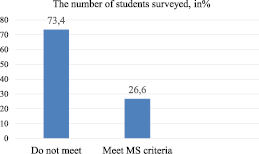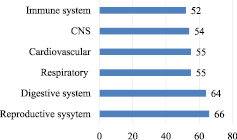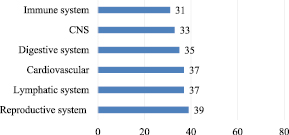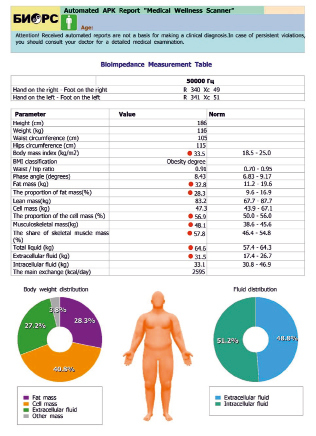The problem of obesity in combination with various metabolic disorders and / or diseases is the focus of modern medical research. In recent years, the metabolic syndrome, characterized by the presence of tissue insulin resistance, hyperinsulinemia, impaired glucose tolerance, primary arterial hypertension, dyslipidemia, and also abdominal obesity and hyperuricemia, has been of great interest to researchers. In recent years, many researchers have proposed expanding the scope of MS, including as components of steatosis of the liver and obstructive sleep apnea syndrome [1].
According to World health organization, about 30 % of the world’s inhabitants (16.8 % of women, 14.9 % of men) are overweight. The prevalence of MS in the general population is high, it ranges from 14-24 % and increases with age. So, among people aged 20–29 years, MS can be diagnosed in 6.7 % of residents; 60–69 years old – in 43.5 %, 70 years and older – in 42 %. The number of obese people is progressively increasing every 10 years by 10 %. Over the past 10 years, the frequency of obesity has increased everywhere by an average of 75 %, and an increase in the number of obese people is projected in all regions of the world. It is believed that by 2025, 40 % of men and 50 % of women will suffer from obesity [1]. People with obesity are 50 % more likely to develop hypertension than people with normal body weight. According to the results of the Framingham study, for every extra 4.5 kg of weight, systolic blood pressure rises by 4.4 mm Hg in men and 4.2 mmHg among women. Isolation of MS into a separate nosological unit is of great clinical importance, since, on the one hand, this condition is reversible, because with appropriate treatment, it is possible to achieve the disappearance or decrease in the severity of its main manifestations, and on the other hand, it precedes the occurrence of cardiovascular diseases, type 2 diabetes mellitus and atherosclerosis. [2, p. 11]. Today, cardiovascular disease (CVM) is the leading cause of death in the world and accounts for 30 % of total mortality, or 17.5 million deaths per year. CVM mortality rates are steadily increasing year by year throughout the world. In Russia, CVM mortality is 903 cases per 100 thousand people. One of the serious risk factors for CVM is overweight, visceral obesity, which leads to the formation of metabolic syndrome [3].
In promising domestic and foreign studies, it was shown that the risk of developing type 2 diabetes in patients with MS is 5–9 times higher than the risk of stroke and coronary heart disease (CHD) and 3 times higher compared to patients without MS [4, p.64; 5, p. 2490; 6, p. 1254]. The presence of abdominal obesity in the patient and two additional criteria is the basis for the diagnosis of his metabolic syndrome [7, p. 48; 8, p. 1439].
As the number of overweight people, cardiovascular diseases, type 2 diabetes mellitus is growing every year, the relevance of studying the etiopathogenesis of the metabolic syndrome is not in doubt.
Aim of the research: to identify risk factors for the development of metabolic syndrome in medical students.
Material and research methods
1. Questioning. We have compiled a questionnaire to identify individuals with overweight and risks of developing metabolic syndrome. As the objects of research were 60 students of the 3rd year of VSMU named after N.N.Burdenko at the age of 20 to 25 years.
2. A study was conducted of students at risk of developing MS by measuring the complex resistance of biological tissues (body composition analyzer) of a person when a weak alternating electric current (bioimpedanceometer) passed through the body on the Medscanner Wellness hardware-software complex.
All the data obtained were subjected to mathematical and statistical analysis using a professional computer with the calculation of average values of samples and correlation coefficients.
Research results and discussion
In 2009, the All-Russian Scientific Society of Cardiology proposed criteria for the diagnosis of metabolic syndrome. The main diagnostic criterion is the central (visceral or abdominal) type of obesity, which is estimated at a waist volume of more than 80 cm in women, more than 94 cm in men.
Additional criteria include the presence of: arterial hypertension (BP> 130/95 mm Hg); increased triglycerides (TG) (> 1.7 mmol / l); a decrease in HDL (<1.0 mmol / l in men and <1.2 mmol / l in women); – increasing LDL (> 3.0 mmol / l); – fasting hyperglycemia (fasting plasma glucose of 6.1 mmol / l or more); impaired glucose tolerance (plasma glucose after exercise is greater than the limits of 7.8-11.1 mmol / l).
According to the results of the survey, it was revealed that 16 students (26.6 %) met the criteria for the diagnosis of MS (Fig. 1).
These students were divided into 2 groups. The 1st group included 6 students (37.5 %), in whose heredity there are cardiovascular diseases. It is noted that these students do not play sports, and lead mainly a sedentary lifestyle (more than 5 hours). They have an irregular meal (1-2 times a day) and periodic use of alcoholic beverages. Group 2 consisted of 10 students (62.5 %), who, in addition to the weight component of the metabolic syndrome, noted malnutrition (at home more than 3 times and frequent snacking outside the home), as well as a relentless increase in emotional stress.

Fig. 1. The results of the survey among medical students
To date, it has been proven that alcohol consumption, lack of exercise, poor nutrition, as well as the relentless growth of emotional stress stresses – all this contributes significantly to the development of obesity, hypertension, increased blood sugar and cholesterol, which significantly increase the risk of developing cardio -vascular pathology, type 2 diabetes and a number of other diseases.
In 16 students selected by preliminary questioning, a body mass index (BMI) was calculated by the ratio of body weight and height. It should be noted that this indicator is widely used for diagnostic purposes to assess the degree of obesity or malnutrition. BMI is directly affected by the type of figure and bone thickness. When examining students for the percentage of body fat, it was found that this indicator is higher than 40 %, with a norm of 21.0 – 32.9 %, while the content of visceral fat was 7 %, which corresponds to the norm (1-9).
A survey using the Medscanner Wellness hardware-software complex showed that the 1st group of students with burdened heredity had obesity of the 1st degree. These students have an average body mass index of 32 (norm 18-25), the proportion of fat mass is on average 11 kg higher than normal, and extracellular fluid and muscle mass are 4 kg higher than normal. When analyzing the risks of developing diseases, it was revealed that these students in the first place have a risk of developing diseases from the reproductive and digestive systems, in second place from the respiratory and cardiovascular systems, and in third place from the central nervous and immune systems (Fig. 2).
It was found that in the 2nd group of students without burdened heredity, there is a slight increase in weight. They have an average body mass index of 27 (norm 18-25), fat mass and extracellular fluid on average increased by 2 kg, and skeletal muscle mass by 3 kg. A decrease in their fat mass and extracellular fluid is observed due to the fact that they regularly engage in sports and lead an active lifestyle. When analyzing the risks of developing diseases, it was revealed that students of the 2nd group are prone to diseases of the lymphatic and reproductive systems (Fig. 3).

Fig. 2. Analysis of the risks of developing diseases of the first group, in %

Fig. 3. Risk analysis of the development of diseases of the second group, in %

Fig. 4. Diagnostic parameters measured on Medical Scanner Wellness
We suggest that an increase in extracellular fluid may be associated with malnutrition in students. The results of the survey showed that most students at risk abuse fast food, and as snacks use foods rich in sodium salts (chips, crackers). Probably with the use of salty foods, the osmolarity of the intercellular fluid increases, leading to a change in the osmotic gradient between the cell and the extracellular space. Therefore, the liquid, according to the law of osmosis, enters towards a osmotic pressure i.e. into the extracellular space. It should be noted that one of the reasons for the increase extracellular fluid may also become excessive aldosterone production by the adrenal cortex.
When examining students using a hardware-software complex The Medical Scanner Wellness also determined the phase angle and cell mass (Fig.4).
Phase angle. It can be considered as a score of muscle tissue state and performance capability as well as a score of metabolic activity. Healthy people are characterized by phase angle score in the upper range of the interval of allowed values. When the person is healthy, high values point to the good state of cell membranes as well as high activity and high proportion of musculoskeletal mass. Sick people (especially with chronic illnesses) are characterized by phase angle score in the lower range of the interval of allowed values. As a general rule, the lower the values, the more unfavorable prognosis for a disease. In both groups of students examined, the phase angle indicator is closer to the top of the interval of acceptable values and averages 8.7 degrees (normal range: 6.8-9.2 degrees).
Cell mass. This part of the lean body mass depends on the age, height and genetic characteristics. Body cell mass includes muscles, organs, the brain, and nervous cells. Therefore fat degradation and maintenance of cell mass (fat loss occurs in this particular tissue) are very important aspects of weight loss. Cell mass loss is a main reason of failure with maintaining the weight loss because the progress is hindered after the first successes. Consequently, it is necessary to keep an adequate nutrition of the cell mass.
The proteins should be included in the diet. They are ‘building blocks’ for all the body cells, enzymes, hormones. Exceptionally proteins can be a source of energy. The body constantly needs proteins because it is essential for the cell mass maintaining. Dietary fats are the source of fat-soluble vitamins A, E, K, D, essential fatty acids, lecithin. The fats are vital source of energy. The fats are part of cells and cell organelles, they are involved in the metabolic processes. Normal proportion of body fat is an important condition of a good health, performance capability, and well-being. Excess of dietary fat can be a threat of liver and pancreas illnesses, obesity, atherosclerotic vascular disease, cholelithiasis. Carbohydrates are the source of energy for all body cells. They form certain enzymes, hormones and other biologically important compounds when paired with proteins. Complex carbohydrates satisfy the appetite perfectly. When the cell mass gets enough energy from the carbohydrates it helps maintain the basal metabolic rate and calorie intake by the body. The cell mass of all examined students is within normal limits (normal range: 43.9-67.1 kg).
Conclusions
Thus, based on the studies, it was found that in the 1st group of students the probability of developing the metabolic syndrome is much higher than in the 2nd group. This is due to the fact that the development of the metabolic syndrome is facilitated by: unhealthy diet, a sedentary lifestyle, and a burden of hered ity in diabetes mellitus and cardiovascular diseases.

